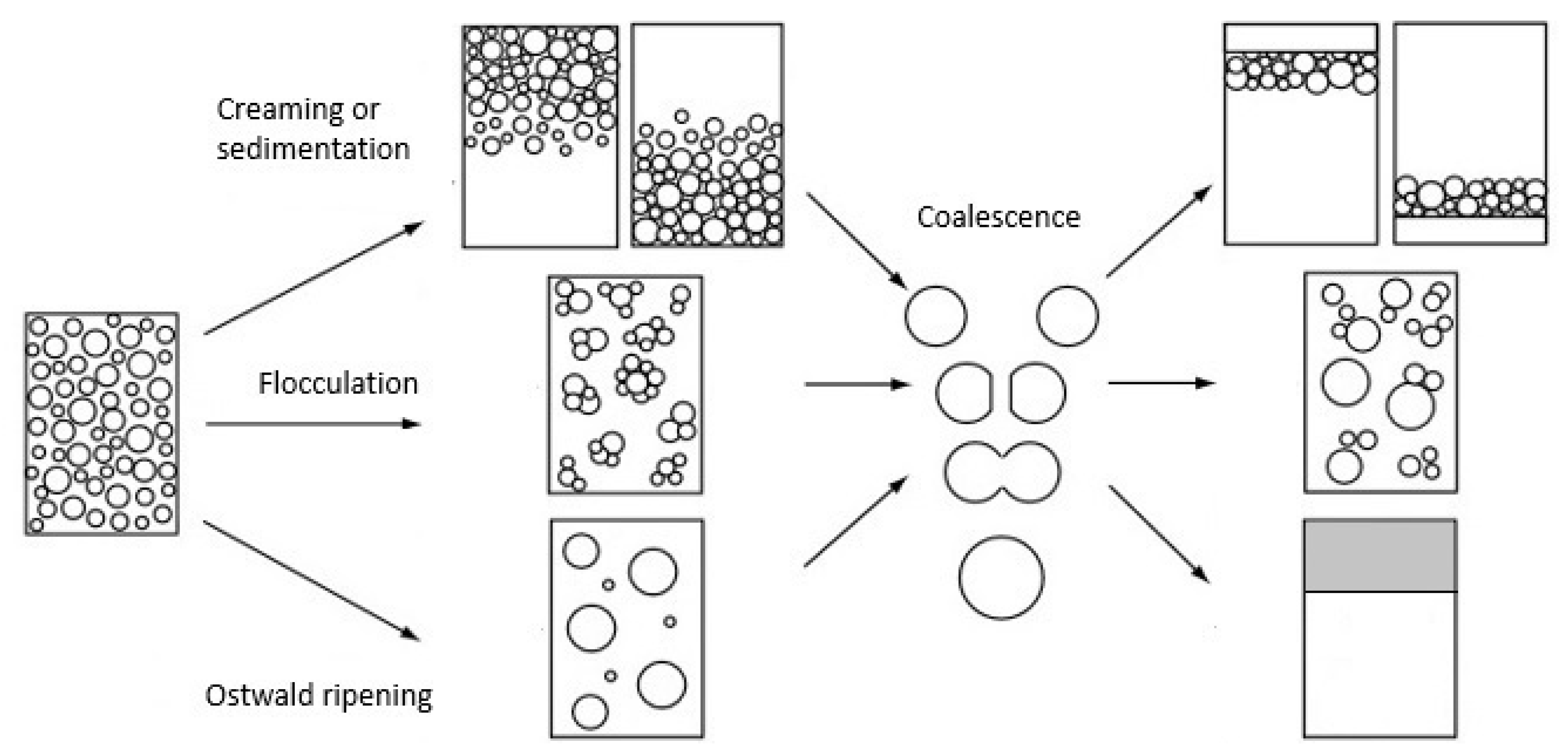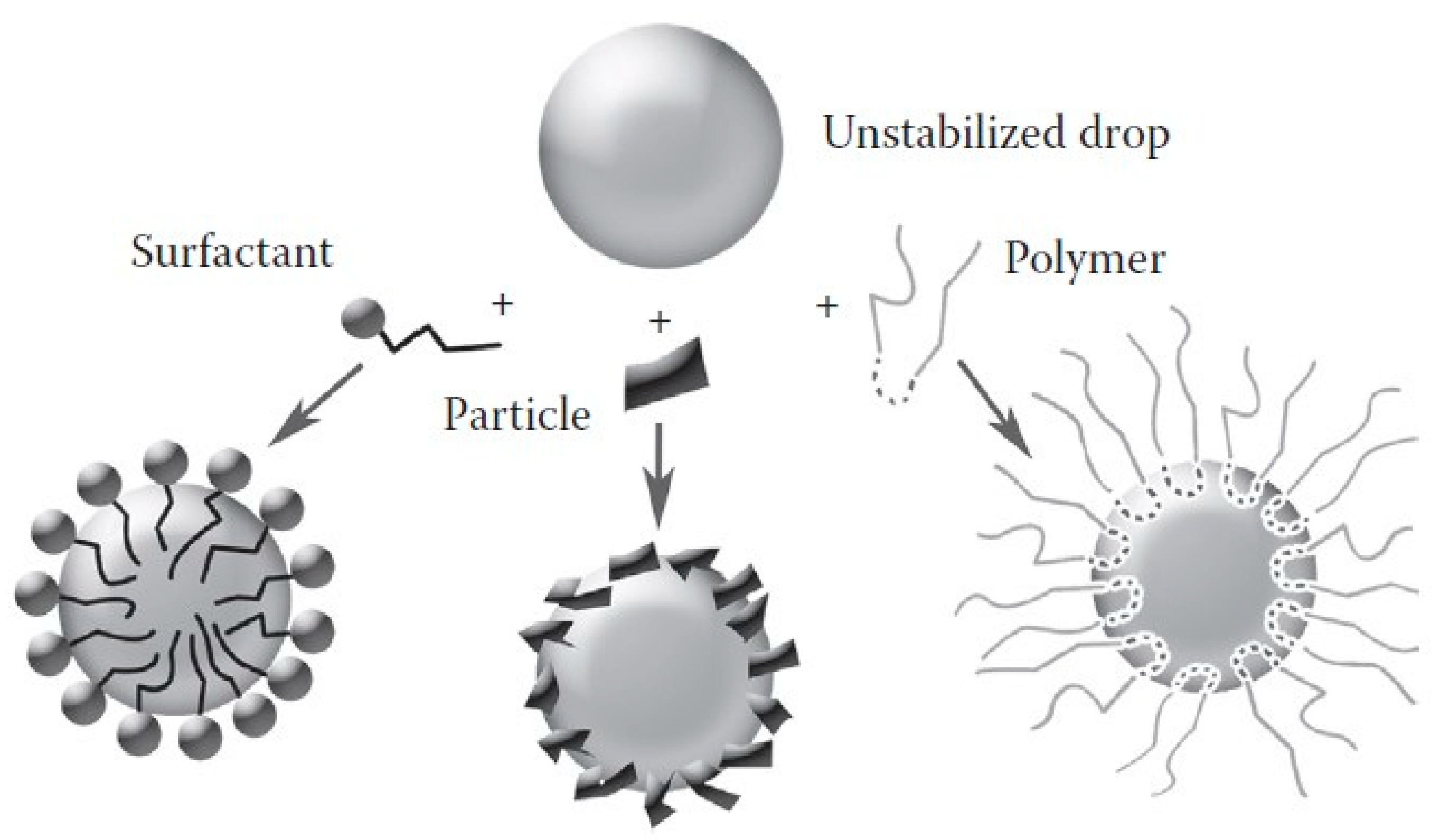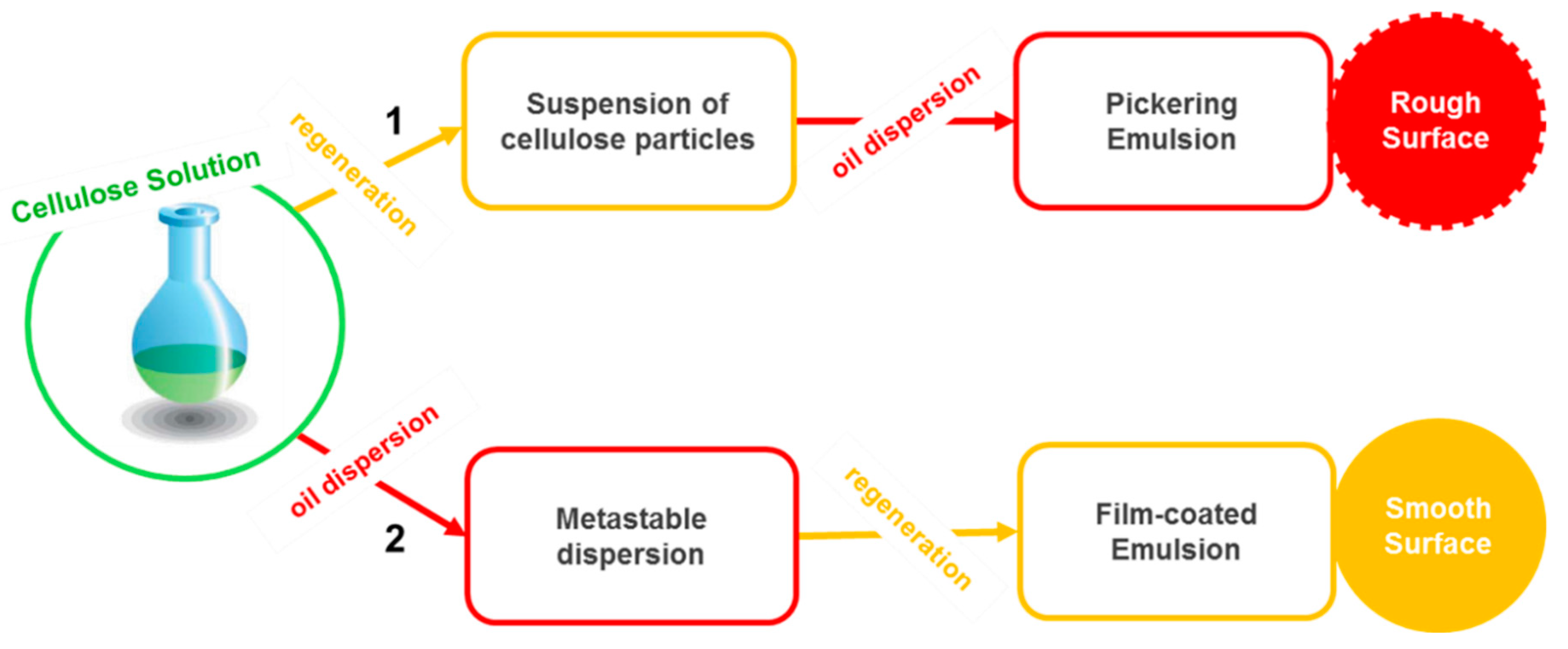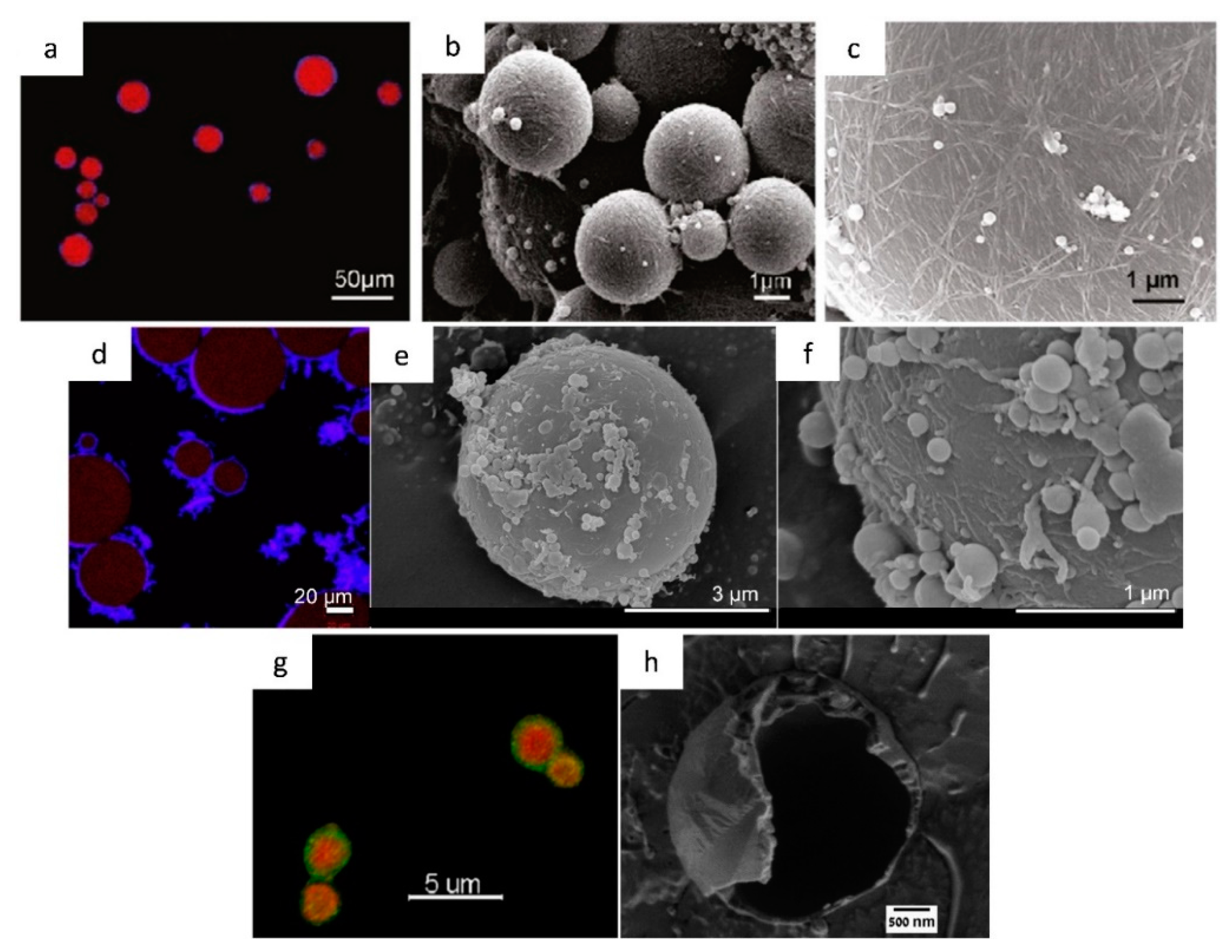Emulsion Formation and Stabilization by Biomolecules: The Leading Role of Cellulose
Abstract
1. Emulsion Stabilization: General Overview
1.1. Emulsions: Morphology and Applications
1.2. Thermodynamic Instability
1.3. The Role of Emulsifiers and Surfactants
2. Emulsions Stabilized by Biomolecules
2.1. Natural Emulsifiers
2.1.1. Phospholipids
2.1.2. Glycosides
2.1.3. Glycolipids
2.1.4. Proteins
2.1.5. Polysaccharides
2.1.6. Natural Colloidal Particles
3. The Emerging Role of Cellulose as an Emulsion Stabilizer
3.1. Physicochemical Characteristics of Cellulose
3.2. Cellulose as an Emulsifier
4. Conclusions
Funding
Acknowledgments
Conflicts of Interest
References
- Kronberg, B.; Holmberg, K.; Lindman, B. Emulsions and emulsifiers. In Surface Chemistry of Surfactants and Polymers; John Wiley & Sons, Ltd.: West Sussex, UK, 2014; pp. 431–445. [Google Scholar]
- Esquena, J. Water-in-water (w/w) emulsions. Curr. Opin. Colloid Interface Sci. 2016, 25, 109–119. [Google Scholar] [CrossRef]
- Schramm, L.L. Biological and medical applications. In Emulsions, Foams, and Suspensions; Wiley-VCH Verlag GmbH & Co. KGaA: Weinheim, Germany, 2005; pp. 325–335. [Google Scholar]
- Schramm, L.L. Food product and agricultural applications. In Emulsions, Foams, and Suspensions; Wiley-VCH Verlag GmbH & Co. KGaA: Weinheim, Germany, 2005; pp. 301–324. [Google Scholar]
- Schramm, L.L. Manufacturing and materials science spplications. In Emulsions, Foams, and Suspensions; Wiley-VCH Verlag GmbH & Co. KGaA: Weinheim, Germany, 2005; pp. 285–300. [Google Scholar]
- Schramm, L.L. Personal care product applications. In Emulsions, Foams, and Suspensions; Wiley-VCH Verlag GmbH & Co. KGaA: Weinheim, Germany, 2005; pp. 337–346. [Google Scholar]
- Bouyer, E.; Mekhloufi, G.; Rosilio, V.; Grossiord, J.-L.; Agnely, F. Proteins, polysaccharides, and their complexes used as stabilizers for emulsions: Alternatives to synthetic surfactants in the pharmaceutical field? Int. J. Pharm. 2012, 436, 359–378. [Google Scholar] [CrossRef] [PubMed]
- McClements, D.J.; Gumus, C.E. Natural emulsifiers-biosurfactants, phospholipids, biopolymers, and colloidal particles: Molecular and physicochemical basis of functional performance. Adv. Colloid Interface Sci. 2016, 234, 3–26. [Google Scholar] [CrossRef] [PubMed]
- McClements, D.J.; Decker, E.A.; Weiss, J. Emulsion-based delivery systems for lipophilic bioactive components. J. Food Sci. 2007, 72, 109–124. [Google Scholar] [CrossRef] [PubMed]
- Sagalowicz, L.; Leser, M.E. Delivery systems for liquid food products. Curr. Opin. Colloid Interface Sci. 2010, 15, 61–72. [Google Scholar] [CrossRef]
- McClements, D.J. Advances in fabrication of emulsions with enhanced functionality using structural design principles. Curr. Opin. Colloid Interface Sci. 2012, 17, 235–245. [Google Scholar] [CrossRef]
- Kronberg, B.; Holmberg, K.; Lindman, B. Colloidal stability. In Surface Chemistry of Surfactants and Polymers; John Wiley & Sons, Ltd.: West Sussex, UK, 2014; pp. 335–360. [Google Scholar] [CrossRef]
- Holmberg, K.; Jönsson, B.; Kronberg, B.; Lindman, B. Emulsions and emulsifiers. In Surfactants and Polymers in Aqueous Solution, 2nd ed.; John Wiley & Sons, Ltd.: West Sussex, UK, 2002; pp. 451–471. [Google Scholar] [CrossRef]
- Dickinson, E. Exploring the frontiers of colloidal behaviour where polymers and particles meet. Food Hydrocoll. 2016, 52, 497–509. [Google Scholar] [CrossRef]
- Salager, J.-L.; Forgiarini, A.; Bullón, J. Progress in designing emulsion properties over a century: Emerging phenomenological guidelines from generalized formulation and prospects to transmute the knowledge into know-how. In Surfactant Science and Technology: Retrospects and Prospects; Romsted, L.S., Ed.; CRC Press Taylor & Francis Group: Boca Raton, FL, USA, 2014; pp. 459–487. [Google Scholar]
- Wang, Z.; Wang, Y. Tuning amphiphilicity of particles for controllable Pickering emulsion. Materials 2016, 9, 903. [Google Scholar] [CrossRef]
- Dickinson, E. Food emulsions and foams: Stabilization by particles. Curr. Opin. Colloid Interface Sci. 2010, 15, 40–49. [Google Scholar] [CrossRef]
- Aveyard, R.; Binks, B.P.; Clint, J.H. Emulsions stabilised solely by colloidal particles. Adv. Colloid Interface Sci. 2003, 100–102, 503–546. [Google Scholar] [CrossRef]
- Kumar, A.; Park, B.J.; Tu, F.; Lee, D. Amphiphilic Janus particles at fluid interfaces. Soft Matter 2013, 9, 6604–6617. [Google Scholar] [CrossRef]
- Binks, B.P.; Fletcher, P.D.I. Particles adsorbed at the oil-water interface: A theoretical comparison between spheres of uniform wettability and “Janus” particles. Langmuir 2001, 17, 4708–4710. [Google Scholar] [CrossRef]
- Fracchia, L.; Cavallo, M.; Martinotti, M.G.; Banat, I.M. Biosurfactants and bioemulsifiers biomedical and related applications-present status and future potentials. In Biomedical Science, Engineering and Technology; Ghista, D.N., Ed.; IntechOpen: London, UK, 2012. [Google Scholar]
- McClements, D.J. Biopolymers in food emulsions. In Modern Biopolymer Science; Kasapis, S., Norton, I.T., Ubbink, J.B., Eds.; Academic Press: San Diego, CA, USA, 2009; pp. 129–166. [Google Scholar] [CrossRef]
- Alizadeh-Sani, M.; Hamishehkar, H.; Khezerlou, A.; Azizi-Lalabadi, M.; Azadi, Y.; Nattagh-Eshtivani, E.; Fasihi, M.; Ghavami, A.; Aynehchi, A.; Ehsani, A. Bioemulsifiers derived from microorganisms: Applications in the drug and food industry. Adv. Pharm. Bull. 2018, 8, 191–199. [Google Scholar] [CrossRef] [PubMed]
- Guiotto, E.N.; Cabezas, D.M.; Diehl, B.W.K.; Tomás, M.C. Characterization and emulsifying properties of different sunflower phosphatidylcholine enriched fractions. Eur. J. Lipid Sci. Technol. 2013, 115, 865–873. [Google Scholar] [CrossRef]
- Lin, X.; Wang, Q.; Li, W.; Wright, A.J. Emulsification of algal oil with soy lecithin improved DHA bioaccessibility but did not change overall in vitro digestibility. Food Funct. 2014, 5, 2913–2921. [Google Scholar] [CrossRef] [PubMed]
- Weete, J.D.; Betageri, S.; Griffith, G.L. Improvement of lecithin as an emulsifier for water-in-oil emulsions by thermalization. J. Am. Oil Chem. Soc. 1994, 71, 731–737. [Google Scholar] [CrossRef]
- Traynor, M.; Burke, R.; Frias, J.M.; Gaston, E.; Barry-Ryan, C. Formation and stability of an oil in water emulsion containing lecithin, Xanthan gum and sunflower oil. Int. Food Res. J. 2013, 20, 2173–2181. [Google Scholar]
- NATSURFACT. Available online: https://natsurfact.com/ (accessed on 30 July 2019).
- AGAE Technologies. Available online: https://www.agaetech.com/ (accessed on 30 July 2019).
- Jezierska, S.; Claus, S.; Van Bogaert, I. Yeast glycolipid biosurfactants. FEBS Lett. 2018, 592, 1312–1329. [Google Scholar] [CrossRef]
- Koh, A.; Wong, A.; Quinteros, A.; Desplat, C.; Gross, R. Influence of sophorolipid structure on interfacial properties of aqueous-arabian light crude and related constituent emulsions. J. Am. Oil Chem. Soc. 2017, 94, 107–119. [Google Scholar] [CrossRef]
- Sałek, K.; Euston, S.R. Sustainable microbial biosurfactants and bioemulsifiers for commercial exploitation. Process Biochem. 2019, 85, 143–155. [Google Scholar] [CrossRef]
- Schaffer, S.; Wessel, M.; Thiessenhusen, A. Cells, Nucleic Acids, Enzymes and Use Thereof, and Methods for the Production of Sophorolipids. U.S. Patent 9,085,787 B2, 2015. [Google Scholar]
- Dalgleish, D.G. Conformations and structures of milk proteins adsorbed to oil-water interfaces. Food Res. Int. 1996, 29, 541–547. [Google Scholar] [CrossRef]
- Lam, R.S.H.; Nickerson, M.T. Food proteins: A review on their emulsifying properties using a structure-function approach. Food Chem. 2013, 141, 975–984. [Google Scholar] [CrossRef] [PubMed]
- Dickinson, E. Hydrocolloids as emulsifiers and emulsion stabilizers. Food Hydrocoll. 2009, 23, 1473–1482. [Google Scholar] [CrossRef]
- Dickinson, E. Hydrocolloids at interfaces and the influence on the properties of dispersed systems. Food Hydrocoll. 2003, 17, 25–39. [Google Scholar] [CrossRef]
- Schulz, M.B.; Daniels, R. Hydroxypropylmethylcellulose (HPMC) as emulsifier for submicron emulsions: Influence of molecular weight and substitution type on the droplet size after high-pressure homogenization. Eur. J. Pharm. Biopharm. 2000, 49, 231–236. [Google Scholar] [CrossRef]
- Kalashnikova, I.; Bizot, H.; Bertoncini, P.; Cathala, B.; Capron, I. Cellulosic nanorods of various aspect ratios for oil in water Pickering emulsions. Soft Matter 2013, 9, 952–959. [Google Scholar] [CrossRef]
- Nasatto, L.P.; Pignon, F.; Silveira, L.J.; Duarte, E.M.; Noseda, D.M.; Rinaudo, M. Methylcellulose, a cellulose derivative with original physical properties and extended applications. Polymers 2015, 7, 777–803. [Google Scholar] [CrossRef]
- Melzer, E.; Kreuter, J.; Daniels, R. Ethylcellulose: A new type of emulsion stabilizer. Eur. J. Pharm. Biopharm. 2003, 56, 23–27. [Google Scholar] [CrossRef]
- Lam, S.; Velikov, K.P.; Velev, O.D. Pickering stabilization of foams and emulsions with particles of biological origin. Curr. Opin. Colloid Interface Sci. 2014, 19, 490–500. [Google Scholar] [CrossRef]
- Tavernier, I.; Wijaya, W.; Van der Meeren, P.; Dewettinck, K.; Patel, A.R. Food-grade particles for emulsion stabilization. Trends Food Sci. Technol. 2016, 50, 159–174. [Google Scholar] [CrossRef]
- Salas, C.; Nypelö, T.; Rodriguez-Abreu, C.; Carrillo, C.; Rojas, O.J. Nanocellulose properties and applications in colloids and interfaces. Curr. Opin. Colloid Interface Sci. 2014, 19, 383–396. [Google Scholar] [CrossRef]
- Bai, L.; Greca, L.G.; Xiang, W.; Lehtonen, J.; Huan, S.; Nugroho, R.W.N.; Tardy, B.L.; Rojas, O.J. Adsorption and assembly of cellulosic and lignin colloids at oil/water interfaces. Langmuir 2019, 35, 571–588. [Google Scholar] [CrossRef] [PubMed]
- Dickinson, E. Biopolymer-based particles as stabilizing agents for emulsions and foams. Food Hydrocoll. 2017, 68, 219–231. [Google Scholar] [CrossRef]
- Calabrese, V.; Courtenay, J.C.; Edler, K.J.; Scott, J.L. Pickering emulsions stabilized by naturally derived or biodegradable particles. Curr. Opin. Green Sustain. Chem. 2018, 12, 83–90. [Google Scholar] [CrossRef]
- Klemm, D.; Philipp, B.; Heinze, T.; Heinze, U.; Wagenknecht, W. Introduction. In Comprehensive Cellulose Chemistry; Wiley-VCH Verlag GmbH & Co. KGaA: Weinheim, Germany, 1998; pp. 1–7. [Google Scholar] [CrossRef]
- Bajpai, P. Pulping Fundamentals. In Biermann’s Handbook of Pulp and Paper, 3rd ed.; Elsevier: Amsterdam, The Netherlands, 2018; Volume 1, pp. 295–351. [Google Scholar] [CrossRef]
- Radotić, K.; Mićić, M. Methods for extraction and purification of lignin and cellulose from plant tissues. In Sample Preparation Techniques for Soil, Plant, and Animal Samples; Micic, M., Ed.; Humana Press: New York, NY, USA, 2016; pp. 365–376. [Google Scholar] [CrossRef]
- Szymańska-Chargot, M.; Chylińska, M.; Gdula, K.; Kozioł, A.; Zdunek, A. Isolation and characterization of cellulose from different fruit and vegetable pomaces. Polymers 2017, 9, 495. [Google Scholar] [CrossRef]
- Klemm, D.; Heublein, B.; Fink, H.-P.; Bohn, A. Cellulose: Fascinating biopolymer and sustainable raw material. Angew. Chem. 2005, 44, 3358–3393. [Google Scholar] [CrossRef] [PubMed]
- Klemm, D.; Kramer, F.; Moritz, S.; Lindström, T.; Ankerfors, M.; Gray, D.; Dorris, A. Nanocelluloses: A new family of nature-based materials. Angew. Chem. 2011, 50, 5438–5466. [Google Scholar] [CrossRef]
- Thomas, B.; Raj, M.C.; Athira, K.B.; Rubiyah, H.M.; Joy, J.; Moores, A.; Drisko, G.L.; Sanchez, C. Nanocellulose, a versatile green platform: From biosources to materials and their applications. Chem. Rev. 2018, 118, 11575–11625. [Google Scholar] [CrossRef]
- Trache, D.; Hussin, M.H.; Hui Chuin, C.T.; Sabar, S.; Fazita, M.R.N.; Taiwo, O.F.A.; Hassan, T.M.; Haafiz, M.K.M. Microcrystalline cellulose: Isolation, characterization and bio-composites application—A review. Int. J. Biol. Macromol. 2016, 93, 789–804. [Google Scholar] [CrossRef]
- Klemm, D.; Schmauder, H.-P.; Heinze, T. Cellulose. In Biopolymers Online; Wiley-VCH Verlag GmbH & Co. KGaA: Weinheim, Germany, 2005. [Google Scholar] [CrossRef]
- Yamane, C.; Aoyagi, T.; Ago, M.; Sato, K.; Okajima, K.; Takahashi, T. Two different surface properties of regenerated cellulose due to structural anisotropy. Polym. J. 2006, 38, 819–826. [Google Scholar] [CrossRef]
- Medronho, B.; Romano, A.; Miguel, M.G.; Stigsson, L.; Lindman, B. Rationalizing cellulose (in) solubility: Reviewing basic physicochemical aspects and role of hydrophobic interactions. Cellulose 2012, 19, 581–587. [Google Scholar] [CrossRef]
- Lindman, B.; Karlström, G.; Stigsson, L. On the mechanism of dissolution of cellulose. J. Mol. Liq. 2010, 156, 76–81. [Google Scholar] [CrossRef]
- Medronho, B.; Lindman, B. Competing forces during cellulose dissolution: From solvents to mechanisms. Curr. Opin. Colloid Interface Sci. 2014, 19, 32–40. [Google Scholar] [CrossRef]
- Glasser, W.G.; Atalla, R.H.; Blackwell, J.; Brown, R.M.; Burchard, W.; French, A.D.; Klemm, D.O.; Nishiyama, Y. About the structure of cellulose: Debating the Lindman hypothesis. Cellulose 2012, 19, 589–598. [Google Scholar] [CrossRef]
- Medronho, B.; Duarte, H.; Alves, L.; Antunes, F.; Romano, A.; Lindman, B. Probing cellulose amphiphilicity. Nord. Pulp Pap. Res. J. 2015, 30, 58–66. [Google Scholar] [CrossRef]
- Yan, L.; Chen, J.; Bangal, P.R. Dissolving Cellulose in a NaOH/thiourea aqueous solution: A topochemical investigation. Macromol. Biosci. 2007, 7, 1139–1148. [Google Scholar] [CrossRef] [PubMed]
- Yan, L.; Gao, Z. Dissolving of cellulose in PEG/NaOH aqueous solution. Cellulose 2008, 15, 789. [Google Scholar] [CrossRef]
- Alves, L.; Medronho, B.F.; Antunes, F.E.; Romano, A.; Miguel, M.G.; Lindman, B. On the role of hydrophobic interactions in cellulose dissolution and regeneration: Colloidal aggregates and molecular solutions. Colloids Surf. A 2015, 483, 257–263. [Google Scholar] [CrossRef]
- Medronho, B.; Duarte, H.; Alves, L.; Antunes, F.E.; Romano, A.; Valente, A.J.M. The role of cyclodextrin-tetrabutylammonium complexation on the cellulose dissolution. Carbohydr. Polym. 2016, 140, 136–143. [Google Scholar] [CrossRef]
- Isobe, N.; Kimura, S.; Wada, M.; Kuga, S. Mechanism of cellulose gelation from aqueous alkali-urea solution. Carbohydr. Polym. 2012, 89, 1298–1300. [Google Scholar] [CrossRef]
- Fujisawa, S.; Togawa, E.; Kuroda, K. Nanocellulose-stabilized Pickering emulsions and their applications. Sci. Technol. Adv. Mater. 2017, 18, 959–971. [Google Scholar] [CrossRef] [PubMed]
- Rein, D.M.; Khalfin, R.; Cohen, Y. Cellulose as a novel amphiphilic coating for oil-in-water and water-in-oil dispersions. J. Colloid Interface Sci. 2012, 386, 456–463. [Google Scholar] [CrossRef] [PubMed]
- Kalashnikova, I.; Bizot, H.; Cathala, B.; Capron, I. New pickering emulsions stabilized by bacterial cellulose nanocrystals. Langmuir 2011, 27, 7471–7479. [Google Scholar] [CrossRef]
- Kalashnikova, I.; Bizot, H.; Cathala, B.; Capron, I. Modulation of cellulose nanocrystals amphiphilic properties to stabilize oil/water interface. Biomacromolecules 2012, 13, 267–275. [Google Scholar] [CrossRef] [PubMed]
- Capron, I.; Cathala, B. Surfactant-free high internal phase emulsions stabilized by cellulose nanocrystals. Biomacromolecules 2013, 14, 291–296. [Google Scholar] [CrossRef]
- Pickering, S.U. CXCVI.-Emulsions. J. Chem. Soc. 1907, 91, 2001–2021. [Google Scholar] [CrossRef]
- Andresen, M.; Stenius, P. Water-in-oil emulsions stabilized by hydrophobized microfibrillated cellulose. J. Dispers. Sci. Technol. 2007, 28, 837–844. [Google Scholar] [CrossRef]
- Lee, K.-Y.; Blaker, J.J.; Murakami, R.; Heng, J.Y.Y.; Bismarck, A. Phase behavior of medium and high internal phase water-in-oil emulsions stabilized solely by hydrophobized bacterial cellulose nanofibrils. Langmuir 2014, 30, 452–460. [Google Scholar] [CrossRef]
- Xhanari, K.; Syverud, K.; Stenius, P. Emulsions stabilized by microfibrillated cellulose: The effect of hydrophobization, concentration and o/w ratio. J. Dispers. Sci. Technol. 2011, 32, 447–452. [Google Scholar] [CrossRef]
- Madivala, B.; Vandebril, S.; Fransaer, J.; Vermant, J. Exploiting particle shape in solid stabilized emulsions. Soft Matter 2009, 5, 1717–1727. [Google Scholar] [CrossRef]
- Asefa, T.; Tao, Z. Biocompatibility of Mesoporous Silica Nanoparticles. Chem. Res. Toxicol. 2012, 25, 2265–2284. [Google Scholar] [CrossRef] [PubMed]
- Kargar, M.; Fayazmanesh, K.; Alavi, M.; Spyropoulos, F.; Norton, I.T. Investigation into the potential ability of Pickering emulsions (food-grade particles) to enhance the oxidative stability of oil-in-water emulsions. J. Colloid Interface Sci. 2012, 366, 209–215. [Google Scholar] [CrossRef] [PubMed]
- Oza, K.P.; Frank, S.G. Microcrystaline cellulose stabilized emulsions. J. Dispers. Sci. Technol. 1986, 7, 543–561. [Google Scholar] [CrossRef]
- Oza, K.P.; Frank, S.G. Multiple emulsions stanbilized by colloidal microcrystalline cellulose. J. Dispers. Sci. Technol. 1989, 10, 163–185. [Google Scholar] [CrossRef]
- Wen, C.; Yuan, Q.; Liang, H.; Vriesekoop, F. Preparation and stabilization of d-limonene Pickering emulsions by cellulose nanocrystals. Carbohydr. Polym. 2014, 112, 695–700. [Google Scholar] [CrossRef] [PubMed]
- Cunha, A.G.; Mougel, J.-B.; Cathala, B.; Berglund, L.A.; Capron, I. Preparation of double Pickering emulsions stabilized by chemically tailored nanocelluloses. Langmuir 2014, 30, 9327–9335. [Google Scholar] [CrossRef]
- Winuprasith, T.; Suphantharika, M. Properties and stability of oil-in-water emulsions stabilized by microfibrillated cellulose from mangosteen rind. Food Hydrocoll. 2015, 43, 690–699. [Google Scholar] [CrossRef]
- Karppinen, A.; Saarinen, T.; Salmela, J.; Laukkanen, A.; Nuopponen, M.; Seppälä, J. Flocculation of microfibrillated cellulose in shear flow. Cellulose 2012, 19, 1807–1819. [Google Scholar] [CrossRef]
- Pääkkö, M.; Ankerfors, M.; Kosonen, H.; Nykänen, A.; Ahola, S.; Österberg, M.; Ruokolainen, J.; Laine, J.; Larsson, P.T.; Ikkala, O.; et al. Enzymatic hydrolysis combined with mechanical shearing and high-pressure homogenization for nanoscale cellulose fibrils and strong gels. Biomacromolecules 2007, 8, 1934–1941. [Google Scholar] [CrossRef]
- Bondeson, D.; Mathew, A.; Oksman, K. Optimization of the isolation of nanocrystals from microcrystalline cellulose by acid hydrolysis. Cellulose 2006, 13, 171. [Google Scholar] [CrossRef]
- Jia, X.J.; Chen, Y.W.; Shi, C.; Ye, Y.F.; Wang, P.; Zeng, X.X.; Wu, T. Preparation and characterization of cellulose regenerated from phosphoric acid. J. Agric. Food Chem. 2013, 61, 12405–12414. [Google Scholar] [CrossRef] [PubMed]
- Alves, L.; Medronho, B.; Antunes, F.E.; Topgaard, D.; Lindman, B. Dissolution state of cellulose in aqueous systems. 1. Alkaline solvents. Cellulose 2016, 23, 247–258. [Google Scholar] [CrossRef]
- Jia, X.; Xu, R.; Shen, W.; Xie, M.; Abid, M.; Jabbar, S.; Wang, P.; Zeng, X.; Wu, T. Stabilizing oil-in-water emulsion with amorphous cellulose. Food Hydrocoll. 2015, 43, 275–282. [Google Scholar] [CrossRef]
- Costa, C.; Mira, I.; Benjamins, J.-W.; Lindman, B.; Edlund, H.; Norgren, M. Interfacial activity and emulsion stabilization of dissolved cellulose. J. Mol. Liq. 2019, 292, 111325. [Google Scholar] [CrossRef]
- Jiménez Saelices, C.; Capron, I. Design of Pickering micro- and nanoemulsions based on the structural characteristics of nanocelluloses. Biomacromolecules 2018, 19, 460–469. [Google Scholar] [CrossRef] [PubMed]
- Napso, S.; Rein, D.M.; Fu, Z.; Radulescu, A.; Cohen, Y. Structural analysis of cellulose-coated oil-in-water emulsions fabricated from molecular solution. Langmuir 2018, 34, 8857–8865. [Google Scholar] [CrossRef]
- Wüstenberg, T. Fundamentals of water-soluble cellulose ethers and methylcellulose. In Cellulose and Cellulose Derivatives in the Food Industry: Fundamentals and Applications; Wüstenberg, T., Ed.; John Wiley & Sons, Incorporated: Weinheim, Germany, 2014. [Google Scholar] [CrossRef]
- Miyamoto, H.; Rein, D.M.; Ueda, K.; Yamane, C.; Cohen, Y. Molecular dynamics simulation of cellulose-coated oil-in-water emulsions. Cellulose 2017, 24, 2699–2711. [Google Scholar] [CrossRef]
- Shen, W.; Guo, L.; Wu, T.; Zhang, W.H.; Abid, M. Stabilizing beverage emulsions by regenerated celluloses. LWT-Food Sci. Technol. 2016, 72, 292–301. [Google Scholar] [CrossRef]
- Hu, H.-Y.; Xing, L.-J.; Hu, Y.-Y.; Qiao, C.-L.; Wu, T.; Zhou, G.-H.; Zhang, W.-G. Effects of regenerated cellulose on oil-in-water emulsions stabilized by sodium caseinate. Food Hydrocoll. 2016, 52, 38–46. [Google Scholar] [CrossRef]
- Sánchez, C.C.; Patino, J.M.R. Interfacial, foaming and emulsifying characteristics of sodium caseinate as influenced by protein concentration in solution. Food Hydrocoll. 2005, 19, 407–416. [Google Scholar] [CrossRef]
- Srinivasan, M.; Singh, H.; Munro, P.A. Sodium caseinate-stabilized emulsions: factors affecting coverage and composition of surface proteins. J. Agric. Food Chem. 1996, 44, 3807–3811. [Google Scholar] [CrossRef]
- Yerramilli, M.; Ghosh, S. Long-term stability of sodium caseinate-stabilized nanoemulsions. J. Food Sci. Technol. 2017, 54, 82–92. [Google Scholar] [CrossRef] [PubMed]
- Napso, S.; Rein, D.M.; Khalfin, R.; Kleinerman, O.; Cohen, Y. Cellulose gel dispersion: From pure hydrogel suspensions to encapsulated oil-in-water emulsions. Colloids Surf. B 2016, 137, 70–76. [Google Scholar] [CrossRef] [PubMed]




| Cellulose Source/Concentration | Co-stabilizer/Concentration | Solvent | Oil Type/Concentration | Homogenization Method | Emulsion Characteristics | Ref. | |||
|---|---|---|---|---|---|---|---|---|---|
| Type | Droplet Size | Rheological Properties | Stability | ||||||
| MCC powder (no specification) | -- | EMIMAC | n-Eicosane 5% w/w | Sonication | Oil-in-water Water-in-oil | 200 nm–20 µm | -- | - No reversible flocculation or irreversible coalescence is observed within 1 year for o/w emulsions. - w/o emulsions are less stable, and phase separation is observed after several months. | [69] |
| MCC powder 0.7%–4% w/w * | -- | EMIMAC | Paraffin | High-shear (Ultra turrax) followed by Sonication | Oil-in-water | 20 µm (a) | -- | -- | [101] |
| MCC powder 0%–1.06% w/v ** | -- | 85% w/w Phosphoric acid aq. solution | Dodecane 10% v/v | High-shear (Ultra turrax) | Oil-in-water | 20 µm (concs > 0.11%) | -- | - No coalescence (concs. > 0.11%). - No creaming (concs. > 0.84%). | [88] |
| MCC powder 0.07%–1.10% w/v ** | -- | 85% w/w Phosphoric acid aq. solution | Dodecane 25% v/v | High-shear (Ultra turrax) | Oil-in-water | 20–40 µm | Gel-like; Viscosity increase during storage | - No coalescence. - No creaming within 3 months (concs. > 0.83%). | [90] |
| MCC powder 3–8 g/kg ** (0.3%–0.8% w/w) | -- | 85% w/w Phosphoric acid aq. solution | Citrus oil 5 to 20mL/L (0.5%–2.0% v/v) | 1. Sonication 2. High-shear (Ultra turrax) | Oil-in-water | 1–3 µm 4–9 µm | Gel-like | - No coalescence. - No creaming within 1 month. | [96] |
| MCC powder 0%–2.0% w/w ** | Sodium caseinate 2.0% w/w * | 85% w/w Phosphoric acid aq. solution | Soybean oil 30% w/w | High-shear (Ultra turrax) | Oil-in-water | 14–32 µm | Gel-like; viscosity increase during storage | - No creaming within 7 days (concs. > 1.0%). - Depletion flocculation prevented for cellulose concentrations above 1.5%. | [97] |
| Sulfite dissolving pulp 0.1% w/w *** | -- | 85% w/w Phosphoric acid aq. solution | Paraffin | Sonication | Oil-in-water | 2–5 µm | -- | - No coalescence. - Reversible flocculation and creaming within 1 day. | [91] |
© 2019 by the authors. Licensee MDPI, Basel, Switzerland. This article is an open access article distributed under the terms and conditions of the Creative Commons Attribution (CC BY) license (http://creativecommons.org/licenses/by/4.0/).
Share and Cite
Costa, C.; Medronho, B.; Filipe, A.; Mira, I.; Lindman, B.; Edlund, H.; Norgren, M. Emulsion Formation and Stabilization by Biomolecules: The Leading Role of Cellulose. Polymers 2019, 11, 1570. https://doi.org/10.3390/polym11101570
Costa C, Medronho B, Filipe A, Mira I, Lindman B, Edlund H, Norgren M. Emulsion Formation and Stabilization by Biomolecules: The Leading Role of Cellulose. Polymers. 2019; 11(10):1570. https://doi.org/10.3390/polym11101570
Chicago/Turabian StyleCosta, Carolina, Bruno Medronho, Alexandra Filipe, Isabel Mira, Björn Lindman, Håkan Edlund, and Magnus Norgren. 2019. "Emulsion Formation and Stabilization by Biomolecules: The Leading Role of Cellulose" Polymers 11, no. 10: 1570. https://doi.org/10.3390/polym11101570
APA StyleCosta, C., Medronho, B., Filipe, A., Mira, I., Lindman, B., Edlund, H., & Norgren, M. (2019). Emulsion Formation and Stabilization by Biomolecules: The Leading Role of Cellulose. Polymers, 11(10), 1570. https://doi.org/10.3390/polym11101570






